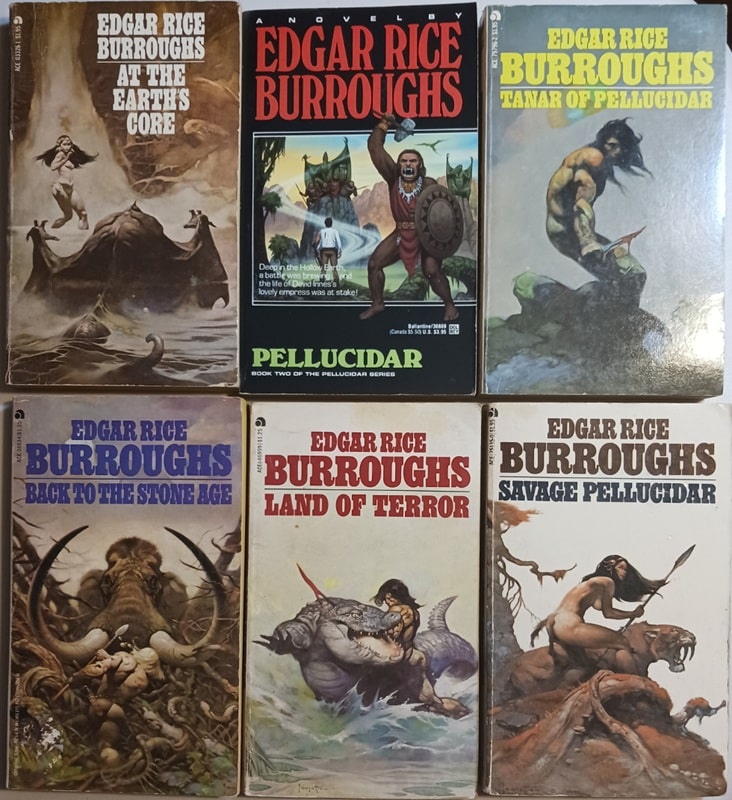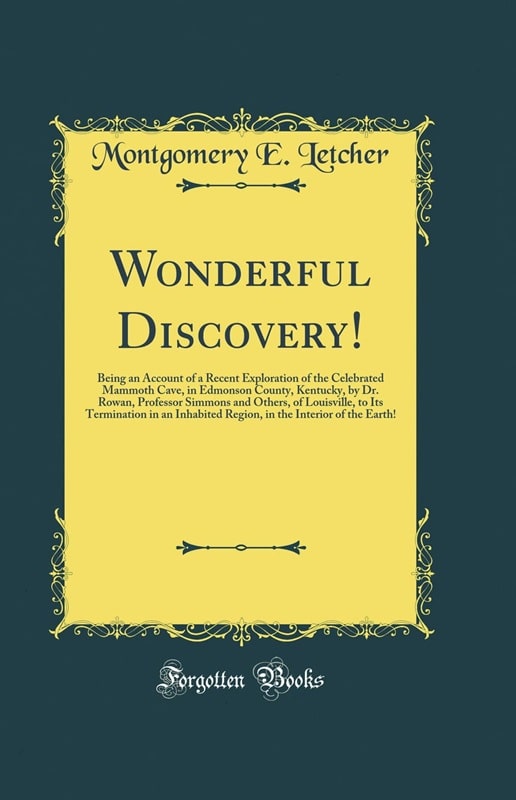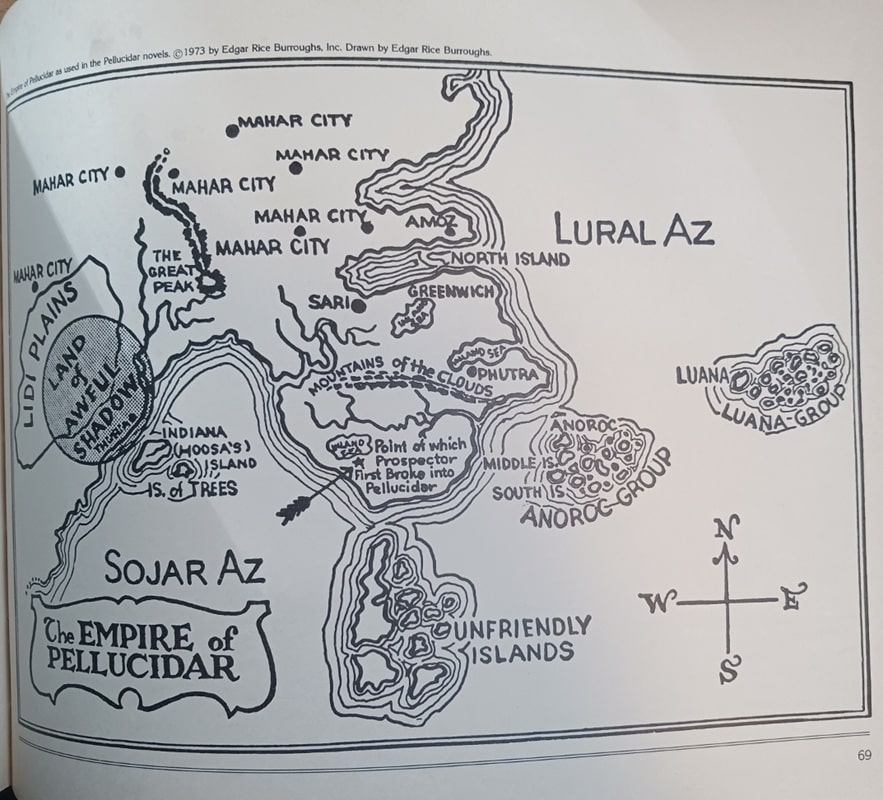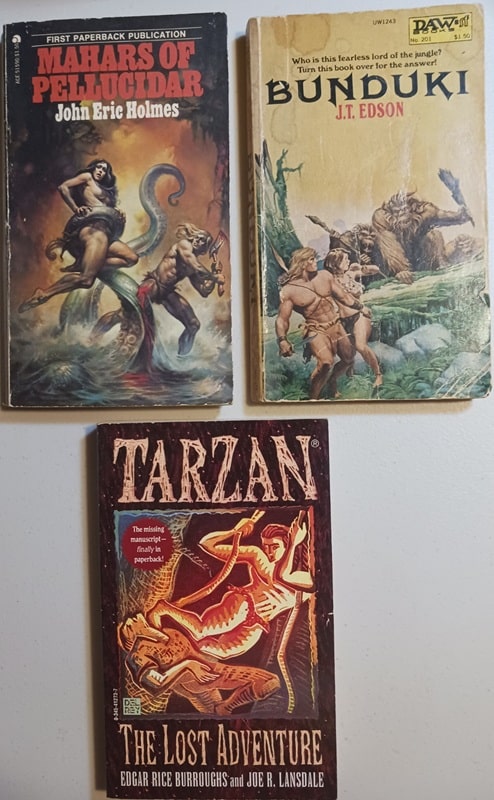The Fiction of Edgar Rice Burroughs, Part IV: The Hollow Earth and Pellucidar

Above are my Edgar Rice Burroughs Pellucidar books. Tarzan at the Earth’s Core goes with this series as well, although I included it in Part II of this series, with my Tarzan collection. In these stories, Pellucidar is a hollow area at the center of the Earth. There are openings into it at the North and South poles, but in the initial book, At the Earth’s Core, an American named David Innes reaches the interior by riding inside a giant drill. This is kind of a reverse of the Sword & Planet plot in which the Earthman is taken outward to another world.
Pellucidar is an interesting construction and ERB clearly gave it some thought. There’s a miniature sun at the center that leads to perpetual day, and the only shadowy area on the surface of Pellucidar is an area of constant twilight beneath the bulk of the unmoving moon. The interior has no horizon because everything curves up and away from the viewer, and the land and water masses are the reverse of the surface, leaving a lot of land. The world is populated by all kinds of extinct outer lifeforms that wandered in through the polar entrances, including some dinosaurs and the remnants of the mammal megafauna.
It also contains humans, and some weird races that never existed on the surface, including the Mahars, who are winged reptilian-like beings possibly evolved from Pterodactyl-like ancestors. The Mahars rule the interior world and David Innes leads a revolt against them that is fought out during the first few books. In Tarzan at the Earth’s Core, Tarzan takes an airship into the interior world and gets involved in the war. Some of the later books are made up of stories that were originally published separately.
There are 7 Pellucidar books, listed below with first publication dates. My copies are all later releases, of course, and all from Ace Books, except for Book 2, From Del Rey. I’ve also listed the publication dates and cover artists here for my copies.
At the Earth’s Core, 1914: 1978, Frazetta
Pellucidar, 1915: 1990, David B. Mattingly
Tanar of Pellucidar, 1929: 1978, Frazetta
Tarzan at the Earth’s Core, 1929-1930 (not shown above)
Back to the Stone Age, 1936-1937: Frazetta cover (My Favorite)
Land of Terror, 1944: 1973, Frazetta
Savage Pellucidar, 1963: 1978, Frazetta
I like the Pellucidar series a lot, and it was the single biggest influence on Lin Carter’s Zanthadon, which I wrote about in a Facebook post quite a while back.

The idea of a Hollow Earth that Burroughs used in his Pellucidar books, or at least of great caverns beneath the earth, is very old. Quite a few Native American tribes have origin stories that include them coming from out of hollows in the earth. Edmond Halley proposed it as a serious theory in 1692, and, of course, there’s Jules Verne’s Journey to the Center of the Earth, published in 1864.
A couple of years ago, my wife and I visited Mammoth Cave in Kentucky and saw evidence of Native Americans having visited and perhaps lived there. I also found out about a book with the lengthy title Wonderful Discovery: Being an account of a recent exploration of the celebrated Mammoth Cave, in Edmonson County, Kentucky, by Dr. Rowan, Professor Simmons and others, of Louisville, to its termination in an inhabited region, in the interior of the Earth.” I managed to find a copy online.

Written in 1839, this story purports to be a journey into the Hollow Earth through the Mammoth Cave system. It’s only a long opening chapter, and supposedly there were to be further installments. This is the only one I’m aware of. This piece has the intrepid explorers getting through the cave system into the inner world where they meet a peaceful group of humans. There’s not much excitement; no “narrative drive,” like you get from ERB.
I was unable to find anything on the author Montgomery E. Letcher. My search suggests this is the only work he ever did. The writing is, naturally, very old fashioned, and the concept was apparently derived from Halley’s suggestion of the Hollow Earth. The story precedes Jules Verne’s Journey to the Center of the Earth by decades, since that book was published in 1864. It seems likely to me, however, that Verne arrived at the idea directly from Halley’s writings rather than from having read this work. And I doubt Burroughs knew about it either.

Above is a map of Pellucidar, from An Atlas of Fantasy. The same basic map is featured in some of the books as well. ERB drew it himself.
ERB and Some Pastiches
Getting back to ERB’s Pellucidar, there’s also a sequel to the series written by John Eric Holmes (1930 – 2010) called Mahars of Pellucidar. It follows the events of Savage Pellucidar. My copy appears to be from the first printing, from ACE, 1976, with a great cover by Boris. I actually enjoyed this tale quite a bit. It was authorized by ERB’s heirs, although they originally nixed a sequel Holmes wrote called Red Axe of Pellucidar. This was eventually published, with the consent of ERB, Inc, although I don’t have it and haven’t read it.

The other books I have shown above with Mahars is Joe Lansdale’s (1951-) fleshed out Tarzan novel Tarzan: The Lost Adventure, which he wrote from a long outline found in ERB’s effects after his death. It’s not quite a pastiche. Nor is it my favorite book from Lansdale, who has written many truly wonderful works. This is from Del Rey, first published in 1995. The cover is by Raymond Verdaguer. I’m sure this is perfectly competent work of art but it didn’t do much for me, and I don’t understand why they didn’t use one of the artists who did the great interior sketches, such as Gary Gianni or Michael Kaluta.
The last pastiche shown here is Bunduki, by J. T. Edson (1928 – 2014), cover by Michael Whelan. It features Tarzan’s adopted son and adopted granddaughter (Bunduki and Dawn). It throws us right into a mystery. Bunduki wakes up in a tree in a tropical jungle, but it isn’t Africa. He’s amazed since he was in a Land Rover that ran over a cliff and should have been dead. Dawn was with him but is missing. It turns out that the two have been mysteriously transported to another world, which turns out to be a counter-earth (opposite our Earth) called Zillikian. This makes it essentially a Sword & Planet novel, although pretty light on the sword part.
Edson wrote three approved novels of Bunduki and a fourth one and some short stories that were not approved by the ERB heirs. I’ve only read the first one but the complete series is:
1. Bunduki, 1975
2. Bunduki and Dawn, 1976
3. Sacrifice for the Quagga God, 1976
4. Fearless Master of the Jungle, 1980
Edson had written a partial fifth novel called Amazons of Zillikian, which was published in 2023. I’ve never seen it. Edson, a British author, was best known for his westerns, particularly a very long series about the Floating Outfit, which ran to 66 books. I’ve read one of those, which was rather intriguing since it involved Cowboys and Aliens.
I might have picked up the other Bunduki books but they are exceedingly expensive in paperback. They are cheap for the Kindle but I’ve got way too many books on Kindle already.
Previous installments in this series include:
The Fiction of Edgar Rice Burroughs, Part I: Sword and Planet
The Fiction of Edgar Rice Burroughs, Part II: Tarzan and The Land That Time Forgot
The Fiction of Edgar Rice Burroughs, Part III: The Westerns and The Mucker
Charles Gramlich administers The Swords & Planet League group on Facebook, where this post first appeared. His last article for Black Gate was The Fiction of Edgar Rice Burroughs, Part III: The Westerns and The Mucker.
I’ve only read a handful of Burroughs titles, none of them hollow earth books. I should really give at least one of them a crack this summer. Are you familiar with David Standish’s “Hollow Earth?” It’s a fun read although by the end it does show the strain of being an expanded magazine piece. Still worth a glance.
God, those are some amazing pieces of cover art.
I haven’t read Standish’s book but I’m familiar with the some of the same sources he used to write it. Looks like a good reference work, though. Thanks for bringing it to my attention.
[…] Rice Burroughs (Black Gate): Above are my Edgar Rice Burroughs Pellucidar books. Tarzan at the Earth’s Core goes with this […]